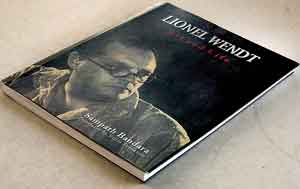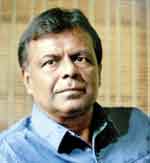Slim volume that says much about the life and work of Lionel Wendt
 “To us the camera is a technical instrument. When it is in the hands of Lionel Wendt, it is a medium of the arts. It is as words are to a poet; paint and brush to a painter,” remarked the celebrated editor, D. B. Dhanapala. Although best known for his photographic abilities, Lionel Wendt was a mixed bag of talent. In the words of Pablo Neruda, “a pianist, photographer, critic and cinematographer Lionel Wendt was the central figure of a cultural life torn between the death rattles of the Empire and a human appraisal of the untapped values of Ceylon.” Few would know that Wendt was also a Barrister with a law degree from the Inner Temple!
“To us the camera is a technical instrument. When it is in the hands of Lionel Wendt, it is a medium of the arts. It is as words are to a poet; paint and brush to a painter,” remarked the celebrated editor, D. B. Dhanapala. Although best known for his photographic abilities, Lionel Wendt was a mixed bag of talent. In the words of Pablo Neruda, “a pianist, photographer, critic and cinematographer Lionel Wendt was the central figure of a cultural life torn between the death rattles of the Empire and a human appraisal of the untapped values of Ceylon.” Few would know that Wendt was also a Barrister with a law degree from the Inner Temple!
His home which he bequeathed to the arts of this country which today stands as the Lionel Wendt Theatre remains the sole motif celebrating the legacy of this iconic artiste who took our arts in all their myriad forms to a new trajectory. Although scholars and scribes have kept the memory of Wendt alive through their written word, largely in English print media, there has been a dearth of books dedicated to the man. In such a vacuum, the attempt by author Sampath Bandara to recapture the globally acclaimed photographer, consummate pianist, the forerunner in the art of criticism, the founder of the first ever collective of modern artists and art lovers- the 43’ Group, through his recently launched publication, ‘Lionel Wendt- Art and Life’, translated by eminent writer, Vijita Fernando is praiseworthy.

Author Sampath Bandara
‘Had there been no Lionel Wendt theatre, then the possibility of his name being buried in the sands of time would be greater,’ notes the author in his preface. All his attempts to trace a biography of this multi-faceted artiste both here and at the British Library in London,had drawn a blank he notes. He also bemoans the fact that no stamp has been issued in his honour so far. The author, drawing material from several literary sources, newspapers and magazines, captures the eventful life of Wendt, his contributions to arts in the country and several celebrated personalities- local and foreign associated with his professional journey including D. R. Wijewardene, Basil Wright, George Keyt and Pablo Neruda.
Wendt who was born to an educated and affluent family- his father Henry Lorenz Wendt, an eminent judge of Burgher descent and mother, Amelia de Saram, daughter of judge Henricus de Saram, was educated at S. Thomas’ College. Despite Wendt’s blue-blooded lineage, his lens sought to freeze the rural Lankan landscape. When Basil Wright arrived in the island to make the film that was to become critically acclaimed as the ‘Song of Ceylon’, it was Wendt he sought as the still photographer for the documentary. In the words of Basil Wright, ‘if there is no Lionel Wendt, then there is no Song of Ceylon.’ Wendt’s devotion to Kandyan dancing and drumming is reflected in this internationally acclaimed documentary which the judges at the Brussels International Film Festival of 1935 dubbed as ‘the most precious poetic creation of a documentary film ever produced in the world.’
A Sarasavi Publication, ‘Lionel Wendt- Art and Life’ also encompasses some selected photographs by Lionel Wendt and enables a window into the life and work of the acclaimed photographer and artiste.
Author Sampath Bandara’s effort in capturing the gifted artist who L.C. Van Geyzel applauds as possessing qualities, ‘both practical and intellectual, which the artist seldom possesses’ in his slim volume is laudable.


